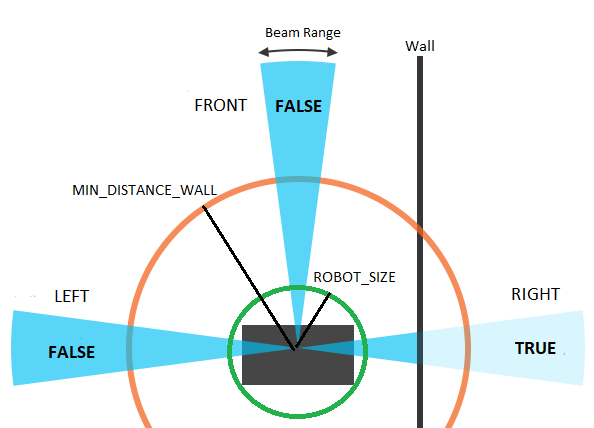Embedded Motion Control 2015 Group 3/Scan
Scan
This page is part of the EMC03 CST-wiki.
In order to solve the maze successfully, the robot needs to be able to drive autonomously. One type of data that is available is the laser range finder data. The PICO robot has a 270 degrees view, with approximately thousand beams.
Potential field
Avoidance collision
The first level of saftey is provided by the potential field algoritm. Its resultant vector will always point towards the direction with the most room and therefore it is sufficient as first layer. However, avoidance collision is one of the top priorities since if Pico bumps into the wall the attempt of solving the maze is over. Another safety layer has been implemented to prevent the robot hitting walls or corners. The distance to the wals is continuosly measured and compared to a set safety margin. If the distance of multiple coextensive beams is smaller than this fixed parameter the robot will move in the oppositie direction.
Detection intersections
At this stage the basic skill of driving with the potential field based on LRF data is completed. Next, the different type of junctions and intersections must be recognized in order to solve the maze. Not only is recognition necassary for driving through the maze, it is also a important part of mapping the maze, see Mapping.
Since the maze is axis alligned there are three possibilites:
- Crossroad
- T-junction
- Open space
Crossroad
Consider an crossroad shown in the picture below, the left plot shows what pico sees when approaching this kind of junction. There are three maxima, which represent the possible directions PICO can go to. By slightly modifying the data the actual vision as seen in the simulator can be constructed, shown in (b).
T-junction
Open space
Constructing virtual walls
Constructing virtual walls is an essential part of driving PICO around the maze. First individual virtual walls were constructed therefore blocking potential corridors, which lead PICO into the desired direction. At a later stage this idea was slightly modified by computing a wall on a radius; therefore, PICO will move more smooth through a corner.
Crossroad
In Figure 1 two minima are shown that represent the far corners between the three maxima. These provide pico with reference points from where the virtual walls are constructed. Dependent on the direction of the desired turn the corner is used as a reference point for computing the radius.
T-junction
In the case of a T-junction the situation is slightly different since with the above method the minima between the two maxima will not represent an corner. However locating this minima is again usefull, dependent on the kind of turn 100+n or 100-n a radius is computed which will represent the walls
